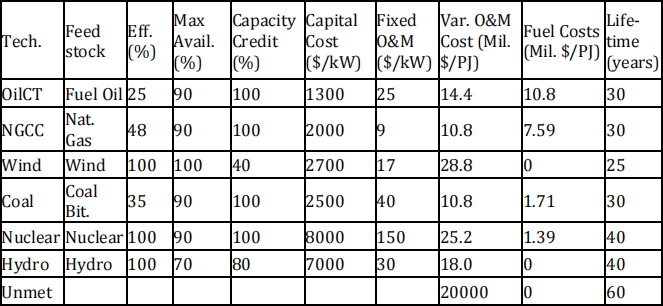BENV0014: ADVANCED ENERGY-ECONOMIC-ENVIRONMENTAL MODELLING
Assessment:
A 3,000-word essay (75%): Submission on or before- 11 am, April 16th, 2024
Submission: A soft copy of the model and 3000 words Essay.
There will be a question and answer session with students on March 22nd, 2024 from 11 am to 12 pm.
3000 words Essay
Students have to submit a 3000-word (excluding reference list) Essay based on a modelling activity. A small energy system model with power and residential sectors modelled, with a reference scenario, will be given to students (available in Moodle page). The database has been modelled in both LEAP and OSeMOSYS framework. Note that the Reference scenario has already been modelled and it should not be modified. All the policy scenarios should be built on the given reference scenario. Students are expected to choose one model (either LEAP or OSyMOSES) and expand it to model the following two policies:
• Energy efficiency improvement policy: reducing household sector 2050 electricity demand by 20% compared to that in the given Reference scenario.
• Climate change mitigation target: reducing 2050 power sector CO2 emissions by 70% compared to that of the given Reference scenario.
Students must develop two research questions relevant to above policies and develop scenarios to answer the research questions.
Following data can be used to model policy scenarios.
As part of your storyline and assumptions made, if requires, you can change the data for the policy scenarios that you will be modelling. But, do not include technologies that are not listed in the tables below in your modelling. And also, do not include new sectors or energy services to the model that was not given to you.
Power sector technology data for ELAP

Power sector data for OSeMOSYS

Energy efficiency improvement opportunities in the household sector:
• new efficient refrigerator, which is 22% more efficient than the existing refrigerator, is available at an additional cost of $0.06/kwh.
• new efficient lamp, which is 50% more efficient than existing lamp, is available at an additional cost of $0.05/kWh.
• new efficient other devices, which is 28% more efficient than existing device, are available at an additional cost of $0.5/kWh.
• new efficient cooking stove, which is 20% more efficient than existing stoves, is available at an additional cost of $0.06/kWh.
Essay content: Please see assessment criteria below
Submissions: Essay (one file) and all model files should be submitted (uploaded) in the Moodle page as a single Zip file.
BENV0014: Assessment criteria for Essay
BENV0014: Learning outcome
At the end of this course students should be able to:
• Fully critique and evaluate alternate energy-economic modelling approaches
• Understand the potential application of energy-economic models in a range of quantitative and analytical research questions
• Run, analyse and evaluate policy issues using simple energy modelling frameworks
|
Content and assessment criteria |
Points (100) |
|
Context and setting up research questions (two research questions). Use of appropriate literatures. High grades: Students must clearly set out the context/background and presenting very specific research questions that can be answered by the given tools (LEAP or OSeMOSYS) and relevant to the content of the Essay. |
10 |
|
Selection of appropriate tool: Critical comparison of models (LEAP vs. OSeMOSYS) based on appropriate literature. Justification to choose either model to answer the research questions. High grades: Application of most appropriate analytic approach to answer the research questions; clear presentation of strength and weakness of the alternate approach. |
10 |
|
Modelling/Data/assumptions and scenarios Clear understanding of data needs and presenting the assumptions made. Policy modelling and choice of efficiency improvement options in household sector (clearly write how the policies are modelled). System boundaries and assumptions made Clearly defining appropriate scenarios to answer research questions. High grades: Effective use of given model (and modelling framework) and data to define the scenarios and constraints with appropriate assumptions clearly stated. Students must define and develop scenarios that are inline with the research questions and useful to gain insights. Constraints and policies are modelled in the most appropriate and simple ways. Advanced thinking and modelling skill. |
40 (20 for modelling) |
|
Results and Discussion High grades: Interpretation of the results and presenting key insights. Presentation and discussion of results inline with and supporting answering research questions. Students must be able to show that they understand how the assumptions made (if any) influence the results. Students must be able to extract key insights from the results. |
20 |
|
Conclusion and policy recommendation/considerations and further work High grades: Summarising the work; Precisely answering research questions drawn from the findings and insights gained from the analysis of results; Clearly listing striking findings and how they can impact policies or presenting policy considerations. Highlight potential weakness in findings (if any) and further work. |
10 |
|
Overall structure: Presentation and correct use of References |
10 |